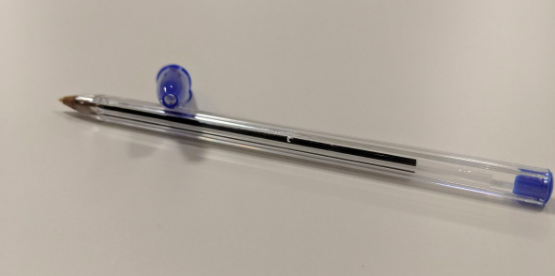The Hole Truth About Ballpoint Pens

Pictured above is a blue ballpoint pen — a Bic Cristal, perhaps the most popular of all ballpoint pen brands. You can write with it and you can draw with it; perhaps you’ll end up with a masterpiece on your hands. Either way, though, you’ll have a masterpiece in your hands — the pen itself is a work of art. There are two Bic Cristals, one blue and one red, on display at the Museum of Modern Art in New York City.
The reason why? Its design. While we take it for granted today, that design went a long way toward convincing fountain pen aficionados to switch. First, note that the chamber is a hexagonal shaft, and not round. That was done to mimic the shape of pencils, something pen users were already familiar with. From day one, the Cristal felt right in your hand. Second, the shaft is transparent, giving consumers a glimpse into the amount of ink remaining — you always knew roughly how much writing you could do before the pen gave out. (And note, for people who were accustomed to dipping a fountain pen in an inkwell, or for those who would grind down pencils, this information was expected.)
But what’s really cool about the pen’s design is what’s missing — or, more accurately, where the holes are. In the image above, you’ll see two of them. First, there’s the one on the shaft — a tiny pinhole near the pen’s center. Second, there’s the hole in the cap, as if the tip were cut off. Why are those there?
The first one has been around for decades — it is there to help the ink flow. If the pen is designed correctly, it is pretty close to air-tight, which creates a problem: as the ink flows out of the pen, something has to fill the space where the ink used to be. If no air flows in, sooner or later, the ink won’t come out. The hole, called a “venting system,” takes care of this. As BIC explains on their website, “the hole on the barrel creates the same level of air pressure inside and outside of the pen, allowing the ink to flow into the point.” Newer pen designs have “less visible venting systems,” per BIC, but the mid-barrel hole has become part of this pen’s familiar design.
When it comes to the second hole, BIC, did, in fact, change the pen. (If you look carefully at the red pen at MoMA, you’ll see the cap seems to come to a point. It has no hole.) In this case, the reason was safety. The pen caps pose a choking hazard; people (and kids in particular) may chew on them, and the cap is just large enough to obstruct someone’s windpipe if accidentally swallowed. Again per BIC’s website again, the Cristals “have a hole in their cap is to prevent the cap from completely obstructing the airway if accidentally inhaled,” as requested by the International Organization for Standardization.
The good news: if you swallow a pen cap, the hole at the top will help keep air flowing. But the cap will still do a lot of damage if swallowed, so you may want to keep it out of your mouth anyway.
Bonus fact: BIC isn’t an acronym. The company is named for its co-founder, a French Baron named Marcel Bich. Bich, per the Wall Street Journal, “dropped the last letter of his surname to avoid mispronunciation.”
From the Archives: The Unforgiving Tyranny of the Red Pen: Red pens break our brains (maybe).
